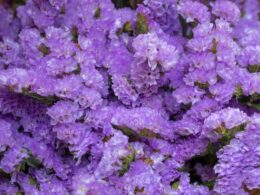Where Does the Name Come From?
The blue passion flower gets its name from its unusual petals, which are said to resemble the crown of thorns worn by Jesus Christ during his crucifixion. In many languages, the name of the blue passion vine often stems from the word passio, which means suffering. Thus, Passiflora means passion, or suffering flower, and caerulea pertains to the color blue. The blue passion flower is also known as: common passion flower, bluecrown passionflower, southern beauty, wild apricot, and flower of the five wounds.
What’s so Special About Passiflora Caerulea?
The blue passion flower is widely renowned for its breathtaking looks. The vine can grow up to 30 feet long, and produces large, blue and white flowers. Each flower has both sepals and petals. There are five light colored petals and five sepals with green underlining. The center of the bluecrown is filled with thin, bright coronal filaments. The filaments are brown by the nectary, white in the middle, and blue at the ends. In the center of the blue passionflower, there are outstretched stigmas and anthers.
The blue crown passion flower gives yellow, or orange fruit. The fruit is oblong, and may have tiny green spots. The inside is red and soft. The fruit of Passiflora caerulea and its hybrids taste bland, and in a few cases even toxic. It is most often consumed by wild animals, including bats and possums; hence, caution is advised during fructification. Because of the toxicity of the plant, the fruit should be eaten ripe.
Can I Grow the Blue Crown Passionflower?
Despite the undeniable beauty of the plant, Passiflora caerulea has become an invasive species in many parts of the world, due to its rapid growth and ability to outcompete native plants. The blue passion vine can cause problems for both people and wildlife. This fast-growing vine can smother other plants, and its tendrils can damage trees by wrapping around them and strangling them.
In addition, the blue passion vine produces a large amount of edible fruit, which can attract animals such as birds, bats, and possums. This can result in the animals spreading the seeds of the vine to new areas, where it can quickly take over. If you’re thinking about planting the vine in your garden, you need to check the regulations in your region.
How to Care for the Blue Passion Vine?
The blue passion vine is a beautiful, hardy, perennial vine, and a winner of the Award of Garden Merit. However, it can be tricky to care for.
- First, the plant is native to the Southern climate, and so it prefers full sun and well-drained soil. If you live in an area with very hot summers, though, you may need to provide partial shade to prevent the leaves from burning.
- Second, water the plant regularly, but be sure not to overwater. Once, or twice if needed, a week should be enough to keep the vine thriving. Remember to keep the soil away from build up.
- Third, start feeding the plant with a balanced fertilizer in early spring. From then on, fertilize every month or so, up to late summer.
- Fourth, prune the vine regularly to keep it under control. Blue passion vine is a vigorous, fast-growing plant. If there’s no cutting applied, the vine may damage neighboring plants.
What Can Harm Passiflora Caerulea?
Though the blue passion flower is relatively easy to grow, it is not immune to common plant diseases. The root system may be quickly damaged by poor quality soil. All the passion flower plants are extremely sensitive to frost, so it’s important to secure the plant for winter. In addition to that, gardeners are advised to regularly check for pests.
Can the Blue Passion Flower Be Used in Medicine?
The blue passion flower has some medicinal properties. Nevertheless, it is important to remember that the plant itself is toxic, and beside the fruit, nobody should consume or use the plant on their own. The leaves and stems can be used to make a tea that has sedative and anti-inflammatory effects. In addition, extracts from the plant are believed to have anticonvulsant, antidepressant, and anxiolytic effects. Passion fruit is sometimes used for pets for anxiety or just to calm them down. The Common passion flower was used in folk medicine, but nowadays, it is mostly used as a supplement.
Is Passiflora Caerulea Poisonous?
The blue passion flower does contain some toxic substances, including cyanogenic glycosides and alkaloids. These toxins can cause nausea, vomiting, and dizziness if ingested in large quantities. The plant’s sap can also cause skin irritation in some people. The toxic parts of the plant are the foliage and the roots. Unlike some other passion flower vines, Passiflora Caerulea is toxic to dogs and cats. While it is not necessarily dangerous to have the plant in your garden, you should avoid eating its flowers or leaves.



















